Cement Manufacturing Plant Financial Model
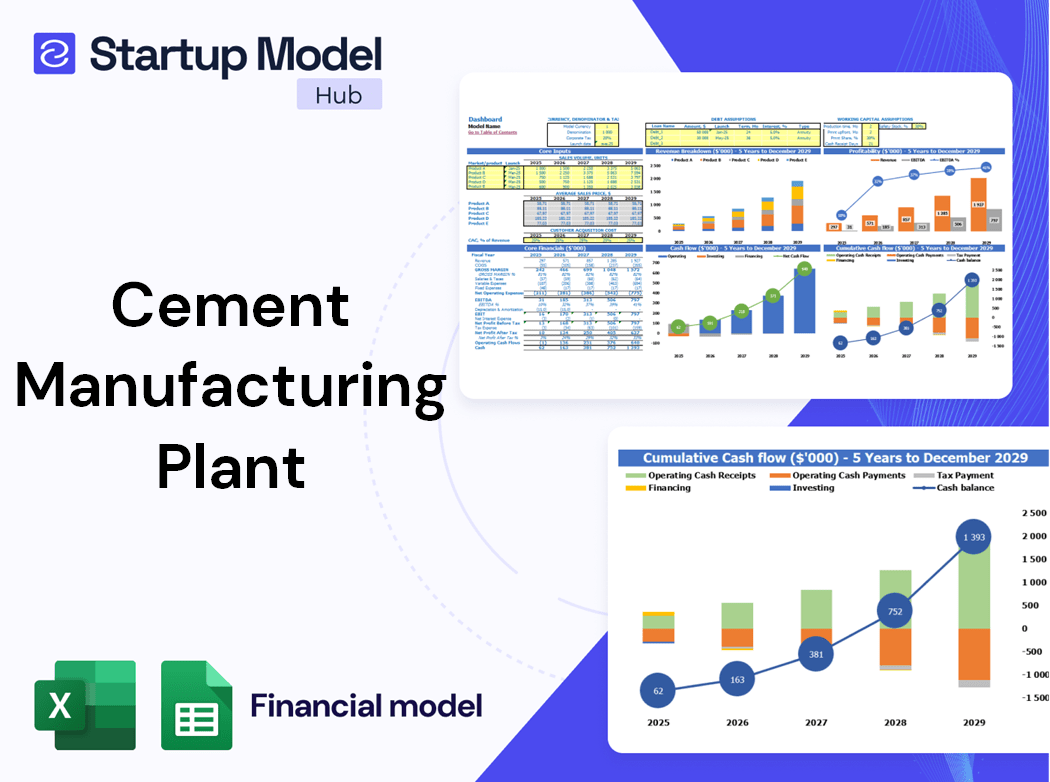
- ✔ 5-Year Financial Projections
- ✔ 100% Editable
- ✔ Investor-Approved Valuation Models
- ✔ MAC/PC Compatible, Fully Unlocked
- ✔ No Accounting Or Financial Knowledge
Cement Manufacturing Plant Financial Model
Bundle Includes:
-
Financial Model
-
Business Plan
-
Pitch Deck
-
Financial Dashboard
ALL IN ONE MEGA PACK - CONSIST OF:
cement manufacturing plant Financial Model/Business Plan Excel Template
Pitch Deck Template For PowerPoint, Keynote & Google Slides
Business Plan Guide and Business Plan Template in MS Word Format
Financial Dashboard in Excel To Track Your Business Performance
CEMENT MANUFACTURING PLANT FINANCIAL MODEL FOR STARTUP INFO
Highlights
In conducting a comprehensive financial analysis for a cement manufacturing plant, it's essential to integrate various methodologies such as capital expenditure forecasting, operating expense modeling, and revenue projection techniques. A detailed cost-volume-profit analysis, along with a robust break-even analysis, provides insights into profitability assessment and the economic feasibility of new projects. Additionally, employing sensitivity analysis in finance enhances our understanding of risks associated with fluctuating market conditions, while cash flow analysis and investment return metrics inform long-term financial planning. By leveraging financial modeling best practices and utilizing financial ratios for manufacturers, we can effectively budget for cement production and forecast potential returns, ensuring that our project financing strategies are well-aligned with supply chain financial impacts. Through scenario analysis in finance, stakeholders are equipped to make informed decisions regarding investment opportunities, ultimately securing funding from banks or investors.
The cement plant financial analysis template serves as an essential tool for addressing key pain points faced by buyers, enabling them to conduct comprehensive manufacturing cost estimation and long-term financial planning with ease. This ready-made financial model simplifies capital expenditure forecasting and operating expense modeling, reducing the complexity often associated with profitability assessment and cash flow analysis. Users benefit from built-in revenue projection techniques and financial ratios for manufacturers, all while leveraging cost-volume-profit analysis and break-even analysis for informed decision-making. With features for financial risk assessment and sensitivity analysis in finance, the template equips stakeholders to navigate project financing for plants confidently, ultimately streamlining budgeting for cement production and ensuring a robust understanding of the supply chain financial impact. The straightforward structure allows immediate input of data, providing a hassle-free experience for startups or those seeking investment, without necessitating additional editing.
Description
This cement manufacturing plant financial analysis template is designed with a comprehensive bottom-up approach, enabling users to grasp the nuances of cash flow analysis and capital expenditure forecasting effectively. It generates detailed revenue projection techniques and operating expense modeling, producing a five-year monthly and annual projection that includes an income statement, balance sheet, and cash flow statement, essential for long-term financial planning. The integrated tools for profitability assessment, break-even analysis, and sensitivity analysis in finance provide insights into financial risk assessment and investment return metrics. Additionally, this model includes cost-volume-profit analysis and budgeting for cement production, allowing manufacturers to evaluate economic feasibility and the supply chain's financial impact while preparing for project financing scenarios and consolidating crucial financial ratios for manufacturers.
CEMENT MANUFACTURING PLANT FINANCIAL MODEL REPORTS
All in One Place
This financial model enhances efficiency by allowing you to input key parameters directly into highlighted cells, triggering automatic updates across 15 interconnected sheets. It facilitates comprehensive cement plant financial analysis, including operating expense modeling, cash flow analysis, and profitability assessment. With organized assumptions centralized in one sheet, you can seamlessly perform capital expenditure forecasting, revenue projection techniques, and break-even analysis. This streamlined approach not only improves budgeting for cement production but also supports long-term financial planning and investment return metrics, ensuring informed decision-making for project financing and economic feasibility studies.

Dashboard
Full transparency with stakeholders enhances both trust and company performance. By sharing cash flow projections, stakeholders can offer valuable insights to optimize financial performance and improve cash flow management. This openness fosters collaborative discussions on long-term financial planning and capital expenditure forecasting, leading to more informed decision-making. Engaging stakeholders in the financial analysis process, including operating expense modeling and profitability assessments, deepens your understanding of the business's economic feasibility and strengthens project financing strategies. Ultimately, this collaborative approach not only boosts stakeholder confidence but also positions the company for sustainable growth and success.
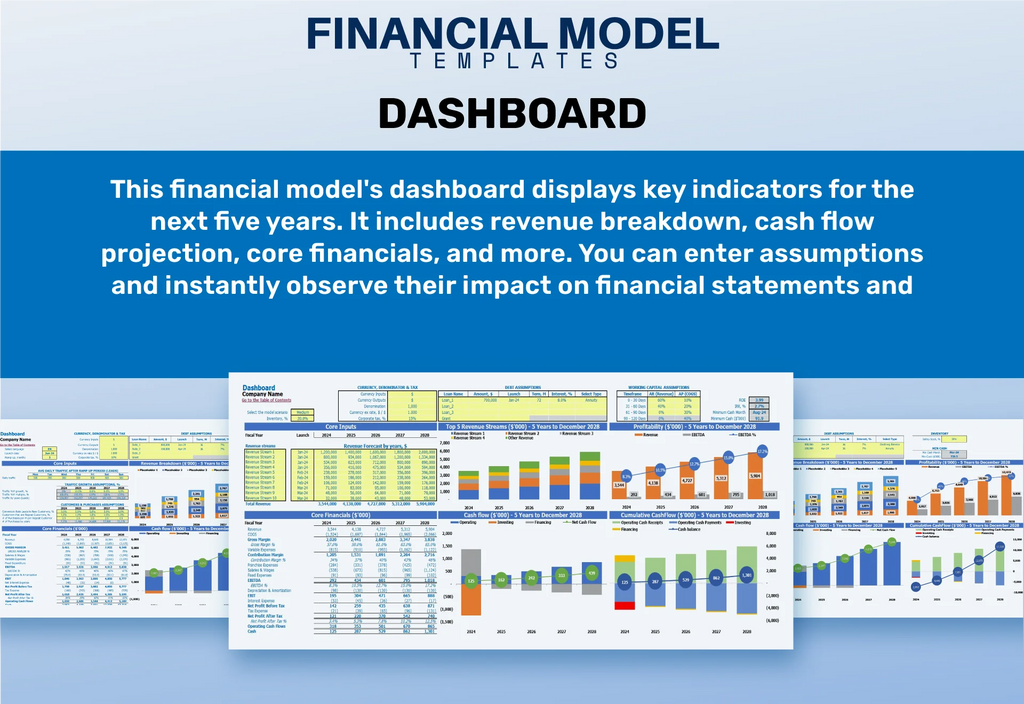
Business Financial Statements
To effectively engage investors and lenders, your profit and loss statement template should incorporate flexible assumptions that facilitate comprehensive financial modeling. This allows for robust financial analysis, including key aspects such as manufacturing cost estimation, cash flow analysis, and profitability assessment. By implementing best practices in financial modeling, you can conduct break-even and sensitivity analyses, ensuring that your economic feasibility study and long-term financial planning meet stakeholder expectations. Ultimately, clear and informative financial statements enhance transparency and support informed decision-making related to capital expenditure forecasting and investment return metrics in your cement plant project.
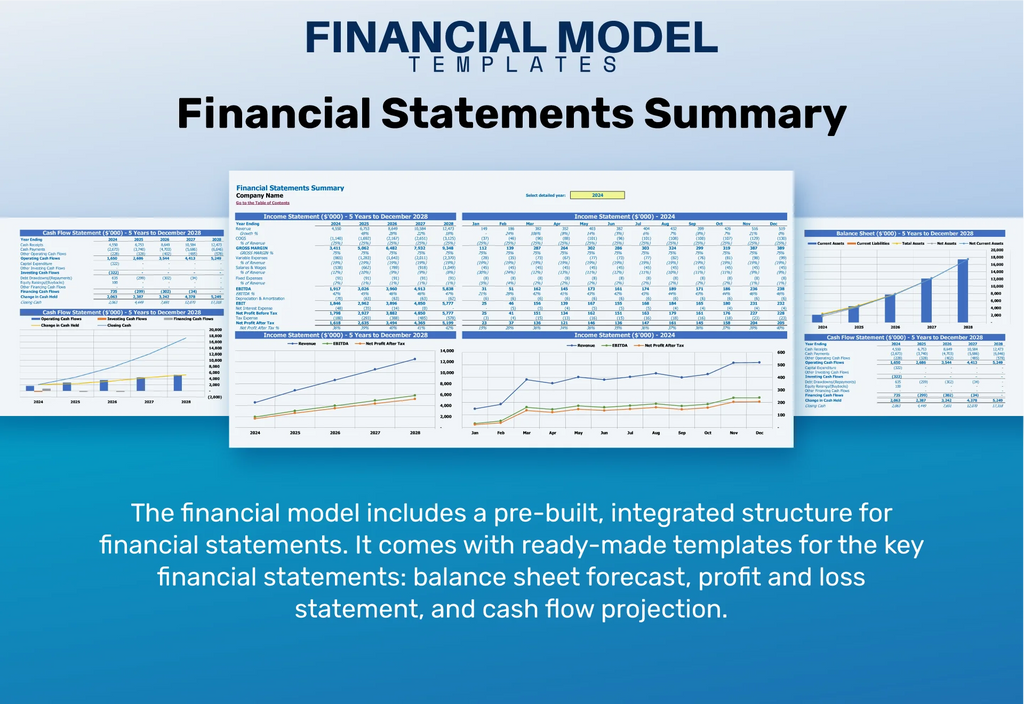
Sources And Uses Statement
This startup costs spreadsheet effectively outlines the sources and uses of capital, providing insights into fund movement and distribution. By integrating key elements like manufacturing cost estimation and capital expenditure forecasting, it serves as a valuable tool for financial modeling best practices. Its comprehensive approach aids in conducting profitability assessments, cash flow analysis, and break-even analysis, ensuring informed decision-making. This resource is essential for long-term financial planning and investment return metrics, offering a clear view of the economic feasibility for cement production ventures.

Break Even Point In Sales Dollars
Understanding break-even analysis is crucial for cement plant financial analysis. It reveals the minimum sales needed to cover costs, offering insight into your business model's viability. By utilizing financial modeling best practices, you can optimize profits by eliminating unnecessary expenses. Furthermore, break-even metrics facilitate cash flow analysis, helping you project when your investment will be recouped. This foresight is essential for managing stakeholder expectations, as it highlights the timeline when revenues surpass costs. Leverage this data for effective long-term financial planning and improved investment return metrics in your cement production budgeting efforts.

Top Revenue
In financial analysis, the top line represents a company's revenues, crucial for assessing performance. Investors focus on top-line growth, a key indicator of increasing gross sales, which positively impacts profitability and overall financial health. Changes in this metric, coupled with operating expenses and cash flow analysis, are essential for comprehensive budgeting and long-term financial planning. Effective manufacturing cost estimation and capital expenditure forecasting contribute to investment return metrics and enhance economic feasibility studies. By leveraging scenario and sensitivity analysis in finance, companies can optimize their financial models and support informed decision-making for sustained growth.
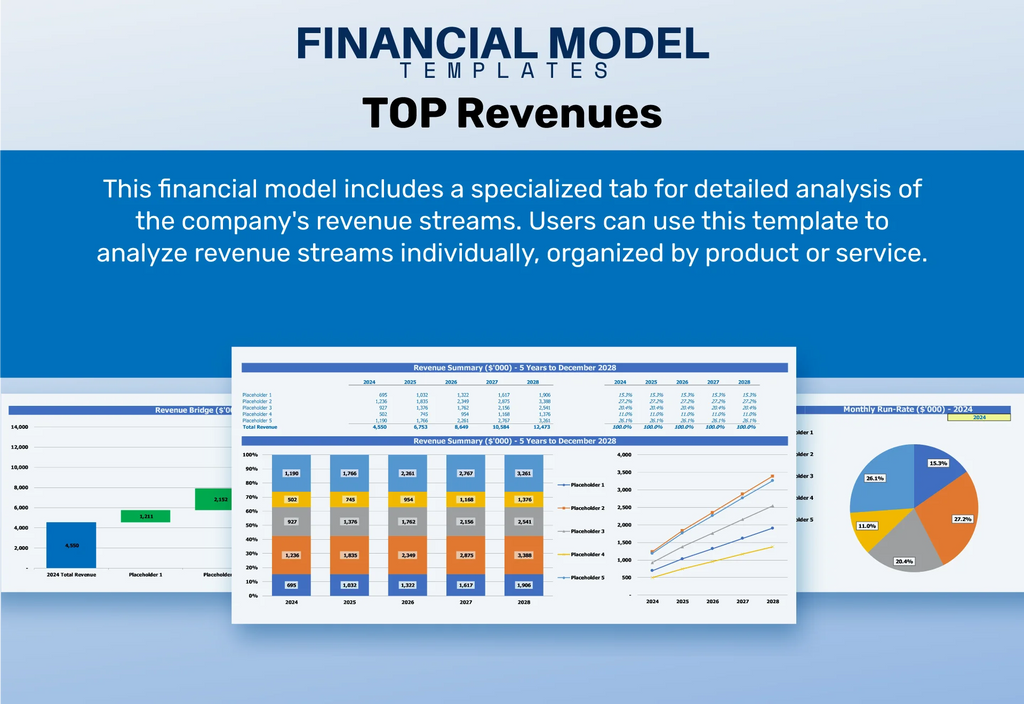
Business Top Expenses Spreadsheet
The Top Expenses tab in our startup financial projection template offers a comprehensive overview of your cement plant's costs, categorized into four key segments. Featuring an integrated annual expense chart, it highlights essential expenditures for client acquisition and employee compensation. Our analysis incorporates both fixed and variable costs, facilitating a robust manufacturing cost estimation. With tools for cash flow analysis and budgeting for cement production, this template supports profitability assessment and long-term financial planning, ensuring you have a clear picture of your financial health as you navigate project financing and operational expenses.

CEMENT MANUFACTURING PLANT FINANCIAL PROJECTION EXPENSES
Costs
Achieve instant clarity and organization with our comprehensive financial model Excel designed specifically for cement plant financial analysis. This template streamlines operating expense modeling, enabling quick forecasting of fixed costs, including R&D and SG&A. With advanced end-to-end formulas across multiple worksheets, it automates cash flow analysis and capital expenditure forecasting, eliminating the hassle of manual updates. Enhance your long-term financial planning with user-friendly tools for profitability assessment, cost-volume-profit analysis, and financial ratios tailored for manufacturers. Make informed decisions with confidence and propel your business towards sustainable growth.

CAPEX Spending
Capital expenditures (CAPEX) form the foundation of a startup budget, driving the development of the company. Through meticulous financial modeling best practices, a comprehensive analysis of manufacturing cost estimation, operating expenses, and cash flow is executed. This financial plan enables efficient long-term financial planning and effective budgeting for cement production. By employing techniques like break-even analysis and scenario analysis in finance, business owners can make informed decisions that enhance profitability assessment and ensure sustainable growth. Ultimately, a well-structured financial framework leads to robust investment return metrics and a solid understanding of financial risk assessment.

Loan Financing Calculator
A loan amortization schedule is an essential tool for stakeholders, outlining periodic payments for amortizing loans. It details how the principal is reduced over time, typically featuring equal payments made regularly. Incorporating a comprehensive startup financial model, it includes a built-in amortization calculator reflecting the initial amount, terms, and interest rates. This schedule enhances long-term financial planning, allowing companies to effectively manage cash flow and assess financial risk. By tracking outstanding debt, businesses can better strategize their repayment plans and ensure alignment with overall investment return metrics.

CEMENT MANUFACTURING PLANT EXCEL FINANCIAL MODEL METRICS
Financial KPIs
Key Performance Indicators (KPIs) are essential for measuring a cement plant's financial health. Our advanced financial model for cement manufacturing enables precise calculation of these critical metrics, facilitating in-depth financial analysis. With features such as cost-volume-profit analysis and cash flow analysis, the model provides clarity in budgeting and long-term financial planning. Additionally, data is visually summarized in charts, enhancing usability for effective decision-making. Whether it's for capital expenditure forecasting or profitability assessment, this model empowers stakeholders to navigate financial landscapes with confidence.
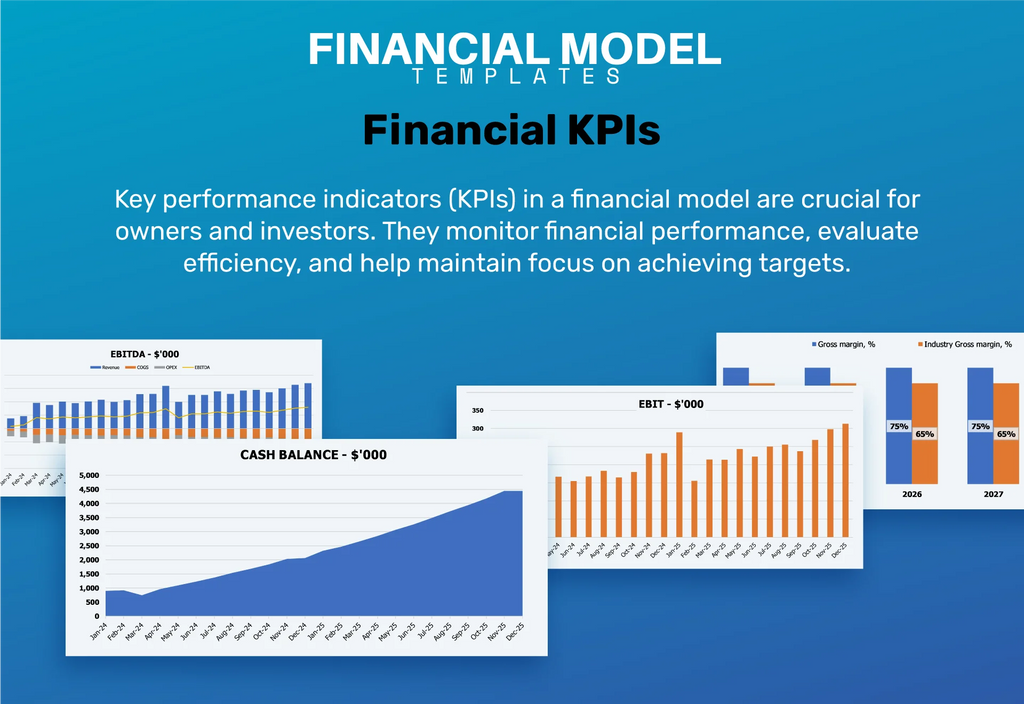
Cash Flow Forecast Excel
A robust cash flow model is essential for any business aiming to optimize financial performance and attract investments. This Excel template facilitates comprehensive cash flow analysis, tracking incoming and outgoing transactions. It incorporates key factors such as payable and receivable days, annual revenue, and working capital to enhance manufacturing cost estimation and operating expense modeling. Additionally, it plays a crucial role in long-term financial planning, aiding in capital expenditure forecasting and sensitivity analysis in finance. Ultimately, this tool supports profitability assessment and investment return metrics, ensuring effective budgeting for cement production and overall financial health.

KPI Benchmarks
The benchmarking tab is crucial in our financial forecasting model. It calculates key industry and financial benchmarks, offering insights into company performance relative to peers. By analyzing these benchmarks, you gain a clearer understanding of top performers in the sector, enabling effective profitability assessment and identifying areas for improvement. This analytical tool supports long-term financial planning and enhances cash flow analysis through targeted investment return metrics, strengthening the overall manufacturing cost estimation process in budgeting for cement production. Leverage this information for a robust financial risk assessment and strategic decision-making.

P&L Statement Excel
Calculating a profit and loss statement is essential for effective financial planning in a cement plant, despite its complexities. Our innovative approach simplifies the process, allowing for accurate sales projections and a clearer view of your financial landscape. By incorporating manufacturing cost estimation, cash flow analysis, and operating expense modeling, you can enhance profitability assessment and make informed decisions. Utilize our tailored tools for budget forecasting and scenario analysis, ensuring long-term sustainability and robust financial performance. Embrace professional financial modeling best practices to achieve your investment return metrics and optimize your overall financial strategy.

Pro Forma Balance Sheet Template Excel
The Monthly and Yearly pro forma balance sheet template is intricately linked with cash flow projections, profit and loss statements, and other vital financial inputs. This comprehensive financial modeling tool empowers users to conduct thorough cement plant financial analysis, facilitating capital expenditure forecasting and operating expense modeling. By integrating revenue projection techniques and break-even analysis, it enables effective cost-volume-profit analysis and provides valuable insights for long-term financial planning. This template supports scenario analysis in finance, ensuring informed decision-making for budgeting and investment return metrics in cement production.

CEMENT MANUFACTURING PLANT FINANCIAL PROJECTION TEMPLATE VALUATION
Startup Valuation Model
This Excel financial template is designed for comprehensive cement plant financial analysis, enabling users to conduct streamlined Discounted Cash Flow valuations with minimal input on the Cost of Capital. Incorporating best practices in financial modeling, it supports robust manufacturing cost estimation, capital expenditure forecasting, and cash flow analysis. Users can enhance profitability assessment through sensitivity analysis and cost-volume-profit analysis, while also facilitating long-term financial planning and investment return metrics. With its user-friendly interface, this template empowers stakeholders to make informed decisions that positively impact the financial health of cement production projects.

Cap Table
A pro forma capitalization table is essential for conducting a comprehensive financial analysis in the cement manufacturing sector. It enables clear visibility into capital allocation and investor equity shares, facilitating informed decision-making. Understanding each financial component is crucial; the cap table serves as a pivotal tool for evaluating profitability, forecasting capital expenditures, and assessing financial risks. This unified view aids in long-term financial planning, optimizing cash flow, and ultimately enhancing the economic feasibility of projects. Utilizing this tool empowers businesses to navigate the complexities of budgeting for cement production and align financial strategies effectively.

KEY FEATURES
A comprehensive financial model enhances decision-making by integrating revenue projections, operating expense modeling, and sensitivity analysis for cement plants.
Our Excel template streamlines financial modeling for cement plants, ensuring compliance with lender requirements and simplifying report preparation.
A robust financial model enables accurate revenue projections and sensitivity analysis, guiding strategic decisions for cement plant profitability and growth.
Robust cash flow analysis enables informed decision-making, ensuring the financial impact of new equipment or products is thoroughly assessed.
Effective financial modeling uncovers potential cash gaps and surpluses, enabling proactive decision-making for enhanced profitability and sustainability.
A robust cash flow analysis empowers timely decisions, preventing deficits while maximizing reinvestment opportunities for growth in your business.
A robust financial model enhances decision-making by providing accurate cost estimations and assessments for long-term profitability in cement production.
This user-friendly financial model empowers cement manufacturers to achieve accurate projections, ensuring informed decision-making and enhanced profitability.
Effective financial modeling enhances budgeting for cement production, enabling better management of surplus cash and informed decision-making.
Effective financial modeling empowers managers to strategically allocate surplus cash for reinvestment and debt repayment, ensuring business sustainability.
ADVANTAGES
A flexible 5-year P&L template enhances budgeting for cement production, enabling precise financial modeling and informed decision-making.
Implementing robust financial modeling best practices empowers cement plants to optimize cash flow, enhancing profitability and reducing financial risk.
Utilizing a comprehensive financial model enables precise revenue projections and enhances investment return metrics for cement plant valuation.
Implementing a robust financial model enhances budgeting, revenue projections, and risk assessments, driving profitability for your cement manufacturing plant.
Utilizing a cement plant financial analysis model enhances strategic decision-making, ensuring optimal cash flow management and improved profitability.




